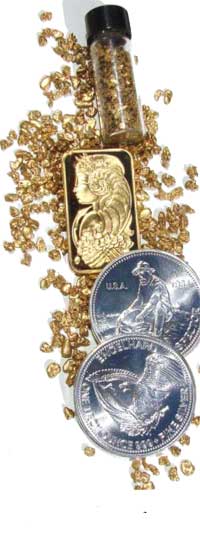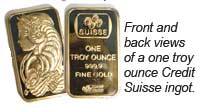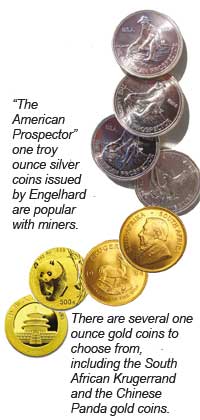All Articles
Free
What's The Best Way To Invest In Gold Or Silver?
August 2008 by Scott
Current headlines highlight our escalating food and fuel prices, mortgage foreclosures, bank bailouts, bankruptcies, and layoffs from American companies that were once thought of as invincible. Throw in some high tension between nations such as Iran and Israel, armed clashes in Iraq and Afghanistan, and it doesn’t paint a very good picture for economic stability.
Many Americans who are fortunate enough to have retirement accounts have watched as the value of those funds decline along with the stock market.
Leonard Melman delves much more deeply into the current economic picture in his column this month on page 47, and explains how political and economic instability tends to cause a rise in the price of gold and other precious metals. He also suggests it might be a good time to buy precious metals as a defensive position.
A question I hear rather frequently from readers is, “What’s the best way to invest in gold or silver?”
As the price of gold continues to rise we may be better off investing our time and research to locate a quality mining claim and recover our own gold. For those of you who don’t have the time or the means available to find gold, or you are just in the wrong part of the country, there are plenty of options available to purchase precious metals.
I want to mention two important points before I continue. First, do not respond to any unsolicited email promising gold or gold dust for sale. There are plenty of shady characters here and overseas who are looking to separate you from your money. All they need is one response in 100,000 to make their efforts worthwhile.
And second, get yourself a safe deposit box or a strong safe that can be securely mounted if you are going to take actual possession of precious metals. A hole in the backyard may give you piece of mind, but it won’t do your family any good when you’re gone and no one in the family has a clue where to start looking.
Purchasing Raw Gold

Gold nuggets are much rarer than fine gold and command a higher price. There are so many variations in size, shape and character that there is no practical way to estimate the value of an individual nugget. The price for a nugget is set by the seller and negotiated by the buyer.
There are a couple of ways to purchase raw gold. Miners and gold dealers often sell raw gold at tradeshows hosted by prospecting clubs and organizations. An experienced miner or dealer should be able to tell you the approximate gold-to-silver ratio of the gold based on the area where the gold was found. Raw, clean gold can be purchased by the troy ounce, partial ounce, pennyweight or gram.
1 troy pound = 12 troy ounces
1 troy ounce = 20 pennyweight or 31.1035 grams, or 480 grains
As mentioned previously, you can expect to pay the current market price per troy ounce or close to it, regardless of the silver content, for fine gold. The price should decrease the more you purchase; however, the price will increase as the size of the gold pieces increase, and you can expect the seller to have the gold separated by size.
Raw gold may also be available at some of the larger tradeshows like the Elko (Nevada) Mining Expo and the Northwest Mining Association
 annual conference and tradeshow. (At the last show in Elko, Newmont Mining Company was selling raw gold that had spilled when workers were pouring doré bars.)
annual conference and tradeshow. (At the last show in Elko, Newmont Mining Company was selling raw gold that had spilled when workers were pouring doré bars.)Another option is to join a local prospecting club and let the members know you would like to purchase gold they are willing to part with.
Coins and Bullion
Coins like the American Gold Eagle are available in one-ounce, half-ounce, quarter-ounce and tenth-ounce denominations.
Other common gold coins include the American Buffalo (maximum 200,000 to be produced), Canadian Maple Leaf and South African Krugerand. You may also see gold Credit Suisse Bars from Switzerland or gold coins from Austria, Belgium, China, England, France, Germany, Mexico, ... and the list goes on.

Gold coins range in size from 1/20-ounce up to 1,000 grams. Gold bars can be found as small as one gram and as large as 400 troy ounces.
You can expect to pay a minimum of the current spot price plus anywhere from 2% to 5%, plus shipping costs, for gold coins or bars in good condition. Current year (2008) coins and uncirculated coins with presentation cases will be priced higher, with proof quality coins higher still.
American Silver Eagle coins are currently selling for a higher premium than silver coins from other countries. In the near term you can expect to pay the current spot price, plus 20% to 25%, plus shipping costs. This is because, in early June 2008, the US Mint stated they were unable to obtain sufficient silver blanks to keep up with demand, although they believed the supply would be back to normal in July.
According to the US Mint, they produced 10.07 million Silver Eagles in the first half of 2008, which is more than they produced in all of 2007.
Silver can also be purchased in 10-ounce, 100-ounce and 1,000-ounce bars and typically has a lower percentage mark-up. Like gold coins, silver coins and bars are available from numerous countries.
Karat is a measure of fineness.
24 Karat = 1000 fine = 100% pure
18 Karat = 750 fine = 75%
14 Karat = 583 fine = 58.3%
A person with a keen eye may be able to pick up some valuable jewelry at estate sales, but care has to be taken that you do not purchase items that are merely gold plated. You can send these items to a refiner and receive payment for their gold content.
Two examples of ETFs in the United States include iShares Silver Trust (symbol: SLV), traded on the American Stock Exchange, and SPDR Gold Shares (GLD), formerly known as StreetTracks Gold ETF, which trades on the New York Stock Exchange.
The funds hold physical metal in storage based on the orders they receive. Both iShares Silver and SPDR Gold charge fees to cover maintenance and storage, and you will see those fees deducted from your balance over time. Annual fees generally average between 0.4% and 0.5%
iShares Silver is priced at 10 troy ounces, so if silver is at $18.00 per ounce then one “share” will trade for about $180. As of mid-July, the fund held 6,092 tonnes of silver.
SPDR Gold is priced at one-tenth troy ounce, so if gold is currently $950 per ounce then one “share” will be trading around $95. You can buy and sell your shares just like any other stock. As of mid-July, the fund held approximately 701 tonnes in storage.
There are a number of investing options available, and you need to choose the option that makes you feel the most comfortable.
See “Mining Stocks—Things to Consider Before You Invest” by Chris Ralph if you are interested in mining stocks. The article appeared in our March 2007 issue.
© ICMJ's Prospecting and Mining Journal, CMJ Inc.